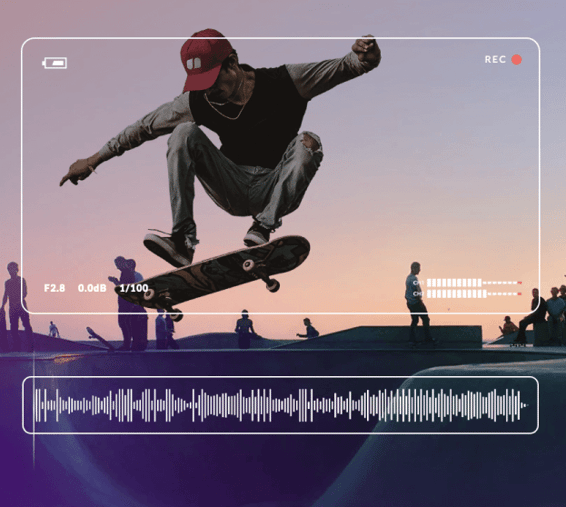Welcome to Outstanding
Royalty Free Folk Music






Listen to our Best Royalty Free Folk Music
We know the right song can make or break your project. That’s why every track in our library is vetted by award-winning producers. Hear for yourself. We've curated a playlist with our best royalty free folk music.
Looking for something different?
We got you. From classical to hip hop to indie, our audio library contains thousands of outstanding tracks. Use one of our 13 filters or check out other curated playlists to find what you need in minutes.
BROWSE THE FULL CATALOG
Dead Simple Licensing
Never worry about licensing again. With Soundstripe, your membership covers the cost for every song license. Just find the right track, download the file, and get a custom license. That’s it. No channel or media-specific fees, no recurring royalties, ever. Here’s more good news: you have unlimited licenses. Go ahead, download as many songs as you want.
Using Royalty Free Folk Music For Your Video Projects
Let’s put down our banjos and mandolins for a minute to talk about folk music.
Oral history is an invaluable tradition, something that has preserved stories and records for thousands of years. In many ways, the basis of our understanding of humanity’s past only exists because of this sort of communal storytelling technique.
And music played a big role in that practice.
“Folk music” is a term we really only hear in Europe and the Americas, but it’s something we can discover in every corner of the world. If there are people singing, chanting, whistling, or clapping, then that culture has a unique and important musical heritage.
This is why folk music is so much more than just Paul Simon, the Mamas and the Papas, or even (if you’re into Viking folk metal) Wardruna. Folk music means different things for different cultures, and that means it’s something worth understanding — especially if you’re interested in adding a cultural or ethnic sound to videos you create.
Folk music around the world
The history of folk music is a long and winding road, made especially difficult because every region has its own unique blend of instruments and styles.
That’s because folk music is...well, the music of the people. (The textbook definition of “folk music” is literally “volksmusik” in German, which translates to “people’s music.”)
This particularly uncreative and somewhat snobbish name was a way to differentiate the commoner’s music from operatic and classical music. But in a way, what it really did was legitimize an entire new source of music outside of religion and art.
Medieval classism aside, the idea name quickly extended to include similar types of music around the world. Folk music encapsulates indiginous cultures, with hundreds or thousands of years of influences that make each one unique.
You should be able to distinguish between Gaelic, Andes, and Tibetan folk music. Part of that comes from our cultural representation of those regions, but that in itself proves the point that different people groups developed very specific songs and musical traditions.
You can also track the evolution of folk music by studying the modern versions or offshoots of it. For example, many different European groups emigrated to North America and brought their music with them. Over time, it evolved into bluegrass — something distinct from its folk music influences, yet clearly connected in many ways.
And when those colonists migrated from the Appalachian region into other parts of the U.S., their music adapted to the rugged Wild West: fewer instruments, a more wistful tone, etc. Country music was born, quickly becoming the more popular and accessible cousin of bluegrass.
Similar evolutions happen all over the world, where people move from one place to another and bring their songs with them. New instruments are adapted, and suddenly it evolves into something new that’s still based on a familiar DNA other people would recognize.
At the end of the day, folk music is whatever people are singing and playing, often tied to regional instruments or a kind of “backyard jam session” vibe to it. And that makes the history of this genre as colorful (and hard to chart) as any other form of oral history.
Common Traits Of Folk Music
When you think about modern folk music in the U.S., you probably think of specific instruments like the guitar, fiddle, upright bass, and banjo. And it’s not exactly the type of music you’d hear at a red carpet event surrounded by cultural elite.
But common traits of folk music extend outside of contemporary American styles. Listen to folk songs from Ireland or Germany and you’ll hear about hard times and regional folklore — themes that pop up in American folk music as well, but not quite the same.
Those themes are perhaps the core, unifying piece for this genre. Things like depression and fairytales are usually topics that a wide variety of people identify with or relate to, but they aren’t things you normally find in mainstream music. Storytelling is an important part of the genre, both as a way to share those stories and also to preserve them.
And as pop music became higher produced and publicized, folk music kept up its unfashionable and lowbrow sensibilities. (Think of it like countercultural punk music that predates spiked hair and distorted guitars.)
Another exciting trait of folk music is that the majority of the songs are from anonymous sources. This stems from being part of oral traditions, or adaptations from fireside stories.
Many of humanity’s oldest songs teach lessons or pass on history, and so there is no singular “owner” or “creator” behind them. This is why the songs are often attributed to a culture or region, and why they are able to travel — along with people — all across the world.
Royalty Free Folk Music For Video
We teased this in the intro, but if you read this far, you’re probably interested in adding folk music to your video projects. And whether you want to create a distinct vibe or match the cultural tones of your footage, royalty free folk music is the perfect tool to do that.
The difficulty here is actually finding that sort of music. A lot of the folk music you’ll find is less “cultural” or “ethnic” music and more just American bluegrass-type songs with banjos and box drums. That’s technically right, but it might not help you make the videos you want.
That’s why finding a good royalty free music library is so important. You don’t just want a few good songs, or a big variety of mediocre ones — you deserve radio-quality songs in a wide range of genres that match the production level of your videos.
Soundstripe does just that. Sure, we’ve got 6,000+ songs written by professional musicians and mixed by award-winning engineers. But we also curate that library to make sure everything is the highest quality, and also matches the sort of project creators need music for.
And all it takes is a subscription. Sign up for a monthly or yearly subscription to Soundstripe, and you’ll get unlimited access to every song in our library. That gets you the royalty free folk music you need...oh, and every other genre you want, no matter how niche you get.
You’ll get great music to help set or match the perfect tone for your projects, no matter how obscure or remote a place you want to highlight.


Have questions? Give us a call
855.224.0847
Soundstripe - Unlimited Music for Video
© 2017-2020 A Product of Soundstripe, Inc
Nashville TN



